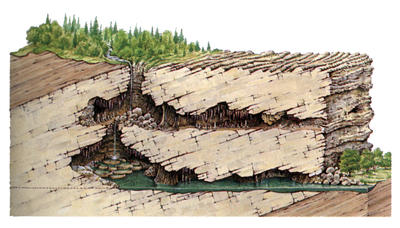|
|
 |
|
|
 |
|
How are caves made?
|
Rainwater absorbs carbon dioxide gas from the air, which makes it acidic. The acid attacks some kinds of rocks, particularly limestone. A limestone bed can be hollowed out by the acidic water passing through it. Weak areas, such as cracks or the gaps between beds, are eroded first, forming horizontal caves along the water table. The water table is the level at which the rocks are saturated with water. When the water table changes, different levels of caves are hollowed out. | | Rainwater flowing underground can hollow out rocks such as limestone and form caves. |
|
| |
Previous:
Back
|
Book:
1001
|
Section:
Earth
|
Chapter:
Landscape
|
|
|
|
 |
|
|






